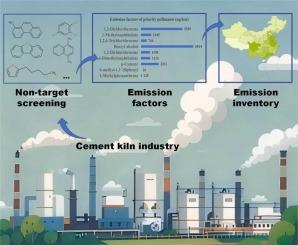Potential emission risks of organic compounds from cement kilns
IF 12.2
1区 环境科学与生态学
Q1 ENGINEERING, ENVIRONMENTAL
引用次数: 0
Abstract
The extensive application of cement kiln industry results in substantial stack gas emissions, posing a potential risk of discharging organic pollutants. Cement industry is not considered as a primary contributor to persistent organic pollutants like polychlorinated dibenzo-p-dioxins and furans (PCDD/Fs), owing to its extremely low emission factor. However, knowledge on the previously unrecognized chemicals that may possess higher emission factors from cement industry is lacking. In this study, non-target screening of pollutants from cement industries were conducted using gas chromatography-quadrupole time-of-flight mass spectrometry. Priority pollutants from cement industry were identified. Alkylated polycyclic aromatic hydrocarbons and chlorobenzene were noteworthy pollutants from cement industry. By comparing the toxicity data and semi-quantitative of the pollutants, 9 chemical compounds, including 1-Methylphenanthrene, were identified as priority pollutants. The emission factors of these selected pollutants from cement industries were about 3-6 orders higher than PCDD/Fs, suggesting a potentially high risk of emission. The nationwide emission estimation indicates a significant release of approximately 300 kilograms of 1-Methylphenanthrene emanating from the cement industry, necessitating heightened attention. The results are helpful for comprehensive risk assessment of organic pollutants from cement industry.

水泥窑有机化合物的潜在排放风险
水泥窑工业的广泛应用导致了大量的烟囱气体排放,造成了潜在的有机污染物排放风险。水泥工业由于其极低的排放系数,不被认为是持久性有机污染物(如多氯二苯并对二恶英和呋喃)的主要来源。然而,对水泥工业中以前未被认识到的可能具有更高排放因子的化学物质的了解是缺乏的。在本研究中,采用气相色谱-四极杆飞行时间质谱法对水泥工业污染物进行非目标筛选。确定了水泥工业的优先污染物。烷基化多环芳烃和氯苯是水泥工业中值得关注的污染物。通过对污染物的毒性数据和半定量比较,确定了1-甲基菲等9种化合物为优先污染物。这些水泥工业污染物的排放因子比PCDD/Fs高约3-6个数量级,具有潜在的高排放风险。全国范围内的排放估计表明,水泥工业释放了大约300公斤的1-甲基菲,需要引起高度重视。研究结果有助于水泥工业有机污染物的综合风险评价。
本文章由计算机程序翻译,如有差异,请以英文原文为准。
求助全文
约1分钟内获得全文
求助全文
来源期刊

Journal of Hazardous Materials
工程技术-工程:环境
CiteScore
25.40
自引率
5.90%
发文量
3059
审稿时长
58 days
期刊介绍:
The Journal of Hazardous Materials serves as a global platform for promoting cutting-edge research in the field of Environmental Science and Engineering. Our publication features a wide range of articles, including full-length research papers, review articles, and perspectives, with the aim of enhancing our understanding of the dangers and risks associated with various materials concerning public health and the environment. It is important to note that the term "environmental contaminants" refers specifically to substances that pose hazardous effects through contamination, while excluding those that do not have such impacts on the environment or human health. Moreover, we emphasize the distinction between wastes and hazardous materials in order to provide further clarity on the scope of the journal. We have a keen interest in exploring specific compounds and microbial agents that have adverse effects on the environment.
 求助内容:
求助内容: 应助结果提醒方式:
应助结果提醒方式:


